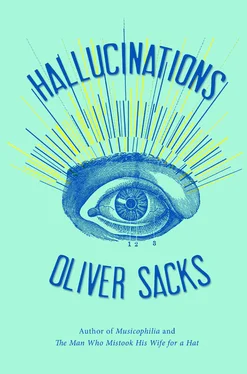Though “flashback” is a visual, cinematic term, auditory hallucinations can be very striking, too. Veterans with PTSD may hallucinate the voices of dying comrades, enemy soldiers, or civilians. Holmes and Tinnin, in one study, found that the hearing of intrusive voices, explicitly or implicitly accusing, affected more than 65 percent of veterans with combat PTSD.
Sometimes this effect can be heightened by medications. In 1970, I had one patient with postencephalitic parkinsonism who was a concentration camp survivor. For her, treatment with L-dopa caused an intolerable exacerbation of her traumatic nightmares and flashbacks, and we had to discontinue the drug.
In the “normal” neuroses commonly brought to psychotherapists, the buried, pathogenic material typically comes from much earlier in life. Such patients are also haunted, but as in the title of Leonard Shengold’s book, they are Haunted by Parents .
Freud was deeply puzzled and troubled by the pertinacity of such post-traumatic syndromes after World War I. Indeed, they forced him to question his theory of the pleasure principle and, at least in this case, to see instead a much grimmer principle at work, that of repetition-compulsion, even though this seemed maladaptive, the very antithesis of a healing process.
Many of the testimonies and accusations in the Salem witch trials described assaults by hags, demons, witches, or cats (which were seen as witches’ familiars). The cats would sit astride sleepers, pressing on their chests, suffocating them, while the sleepers had no power to move or resist. These are experiences we would now interpret in terms of sleep paralysis and night-mare, but which were given a supernatural narrative. The whole subject is explored by Owen Davies in his 2003 article “The Nightmare Experience, Sleep Paralysis, and Witchcraft Accusations.”
Other conditions have also been suggested as contributing to the hallucinations and hysteria of seventeenth-century New En gland. One hypothesis, which Laurie Winn Carlson proposes in her book A Fever in Salem , sees the madness as a manifestation of a postencephalitic disorder.
Others have proposed that ergot poisoning played a part. Ergot, a fungus containing toxic alkaloid compounds similar to LSD, can infest rye and other grains, and if contaminated bread or flour is eaten, ergotism may result. This happened frequently in the Middle Ages, and it could cause agonizing gangrene (which led to one of its popular names, St. Anthony’s fire). Ergotism could also cause convulsions and hallucinations very similar to those of LSD.
In 1951, an entire French village succumbed to ergot poisoning, as John Grant Fuller described in his book The Day of St. Anthony’s Fire . Those affected endured several weeks of terrifying hallucinations and often compulsions to jump from windows, as well as extreme insomnia.
This was shown experimentally by Brady and Levitt in a 1966 study, in which they suggested to hypnotized subjects that they “see” (i.e., hallucinate) a moving visual stimulus (a rotating drum with vertical stripes). The subjects’ eyes, as they did this, showed the same automatic tracking movements (“optokinetic nystagmus”) that occur when one is actually looking at such a rotating drum — whereas no such movements occur (and they are impossible to feign) if one merely imagines such a visual target.
The term “out-of-body experience” was introduced in the 1960s by Celia Green, an Oxford psychologist. While there had been stories of out-of-body experiences for centuries, Green was the first to systematically examine a large number of firsthand accounts, from more than four hundred people whom she located by launching a public appeal through the newspapers and the BBC. In her 1968 book, Out-of-the-Body Experiences , she analyzed these in detail.
Several of Celia Green’s subjects described similar feelings. “My mind was clearer and more active than before,” one wrote; another spoke of being “all-knowing and understanding.” Green wrote that such subjects felt they “could obtain an answer to any question they chose to formulate.”
August Strindberg noted, in his autobiographical novel Inferno , an odd body double, an “other” who mirrored his every movement.
This unknown man never uttered a word; he seemed to be occupied in writing something behind the wooden partition that separated us. All the same, it was odd that he should push back his chair every time I moved mine. He repeated my every movement in a way that suggested that he wanted to annoy me by imitating me.… When I went to bed the man in the room next to my desk went to bed too.… I could hear him lying there, stretched out parallel to me. I could hear him turning the pages of a book, putting out the lamp, breathing deeply, turning over and falling asleep.
Strindberg’s “unknown man” is identical with Strindberg in one sense: a projection of him, at least of his movements, his actions, his body image. Yet, at the same, he is someone else, an Other who occasionally “annoys” Strindberg, but perhaps, at other times, seeks to be companionable. He is, in the literal sense of the term, Strindberg’s “Other,” his “alter ego.”
It is likely that there was popular or folk knowledge of the phenomenon long before there were any medical descriptions.
Twenty years before Weir Mitchell named phantom limbs, Herman Melville included a fascinating scene in Moby-Dick , where the ship’s carpenter is measuring Captain Ahab for a whalebone leg. Ahab addresses the carpenter:
Look ye, carpenter, I dare say thou callest thyself a right good workmanlike workman, eh? Well, then, will it speak thoroughly well for thy work, if, when I come to mount this leg thou makest, I shall nevertheless feel another leg in the same identical place with it; that is, carpenter, my old lost leg; the flesh and blood one, I mean. Canst thou not drive that old Adam away?
[The carpenter replies:] Truly, sir, I begin to understand somewhat now. Yes, I have heard something curious on that score, sir; how that a dismasted man never entirely loses the feeling of his old spar, but it will be still pricking him at times. May I humbly ask if it be really so, sir?
It is, man [says Ahab]. Look, put thy live leg here in place where mine once was; so, now, here is only one distinct leg to the eye, yet two to the soul. Where thou feelest tingling life; there, exactly there, there to a hair, do I.
The importance of first-person accounts was emphasized by William James in his 1887 paper “The Consciousness of Lost Limbs”:
In a delicate inquiry like this, little is to be gained by distributing circulars. A single patient with the right sort of lesion and a scientific mind, carefully cross-examined, is more likely to deepen our knowledge than a thousand circulars answered as the average patient answers them, even though the answers be never so thoroughly collated by the investigator.
The reason for this was not to be clarified until a century later, when it became possible to visualize, with fMRI, the gross changes in the brain’s body mapping that could occur after an amputation. Michael Merzenich and his colleagues at UCSF, working with both monkeys and humans, have shown how rapid and radical such changes may be.
Despite categorical assertions by many that “congenital” phantoms cannot occur, there have been several reports (as Scatena has noted in a review of the subject) indicating that some people with aplasia — congenitally defective or absent limbs — do have phantoms. Klaus Poeck, in 1964, described an eleven-year-old girl born without forearms or hands who was able to “move” her phantom hands. As Poeck wrote, “In her first years at school, she had learned to solve simple arithmetic problems by counting with her fingers.… On these occasions she would place her phantom hands on the table and count the outstretched fingers one by one.”
Читать дальше












